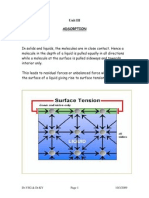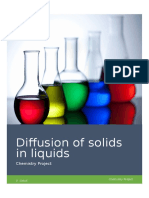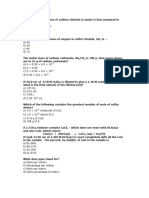Chemistry Project
Chemistry Project
Uploaded by
Akshit BhandariCopyright:
Available Formats
Chemistry Project
Chemistry Project
Uploaded by
Akshit BhandariOriginal Title
Copyright
Available Formats
Share this document
Did you find this document useful?
Is this content inappropriate?
Copyright:
Available Formats
Chemistry Project
Chemistry Project
Uploaded by
Akshit BhandariCopyright:
Available Formats
INTRODUCTION
Since solids exist because of intermolecular forces between the repeating units that make up the lattice, those intermolecular forces are unsaturated or unsatisfied at the surface of the solid. In the interior of the solid, each molecule (if it is a molecular solid) is surrounded on all sides by identical molecules. At the surface of such a solid, however, each molecule is only partially surrounded by identical molecules; when it is not surrounded by identical molecules, any available molecule or ion is adsorbed to its surface. The solid phase is called the adsorbent. The molecules that are absorbed on the absorbent are collectively called the absorbed phase or absorbate. The absorbate is either a gas(molecules) or a solute(molecules or ions) in a solution. In this experiment, we will investigate the adsorption of acetic acid in aqueous solution on activated charcoal.
Adsorption by a solid is not a very important process unless the solid has a very large surface compared to its mass. Consequently, charcoal made from bone, blood, or coconut shells is specially effective because it has a highly porous structure. Charcoal is activated by 1
being heated to quite high temperatures in a vaccum or in a stream of dry air. This stream desorbes the hydrocarbons that are adsorbed when the charcoal is first produced. Charcoal , a covalently bonded solid, is more effective at absorbing molecules than ions. Silver chloride, on the other hand, forms as a precipitate of nearly colloidal dimensions if precipitated rapidly; in colloidal form it has a very high surface-to-mass ratio and readily adsorbes ions from solutions, often to the dismay of analytical chemists.
Meaning of Adsorption
Adsorption is the adhesion of atoms, ions, biomolecules or molecules of gas, liquid, or dissolved solids to a surface. This process creates a film of the adsorbate (the molecules or atoms being accumulated) on the surface of the adsorbent. It differs from absorption, in which a fluid permeates or is dissolved by a liquid or solid. The term sorption encompasses both processes, while desorption is the reverse of adsorption. It is a surface phenomenon. Similar to surface tension, adsorption is a consequence of surface energy. In a bulk material, all the bonding requirements (be they ionic, covalent, or metallic) of the constituent atoms of the material are filled by other atoms in the material. However, atoms on the surface of the adsorbent are not wholly surrounded by other adsorbent atoms and therefore can attract adsorbates. The exact nature of the bonding depends on the details of the species involved, but the adsorption process is generally classified as phsiosorption (characteristic of weak van der wall forces) or chemisorption (characteristic of covalent bonding). It may also occur due to electrostatic attraction.
Application of Adsorption
Adsorption is present in many natural physical, biological, and chemical systems, and is widely used in industrial applications such as activated charcoal, capturing and using waste heat to provide cold water for air conditioning and other process requirements (adsorption chillers), synthetic resins, increase storage capacity of carbide-derived carbons for tunable nanoporous, and water purification. Adsorption, ion exchange, and chromatography are sorption processes in which certain adsorbates are selectively transferred from the fluid phase to the surface of insoluble, rigid particles suspended in a vessel or packed in a column. Lesser known, are the pharmaceutical industry applications as a means to prolong neurological exposure to specific drugs or parts thereof.
Birth of Freudlich Equation
The Freundlich equation or Freundlich adsorption isotherm is an adsorption isotherm, which is a curve relating the concentration of a solute on the surface of an adsorbent, to the concentration of the solute in the liquid with which it is in contact. In 1909, Freundlich gave an empirical expression representing the isothermal variation of Adsorption of a quantity of gas adsorbed by unit mass of solid adsorbent with pressure. This equation is known as Freundlich Adsorption Isotherm or Freundlich Adsorption equation. There are basically two well established types of adsorption isotherm: the Freundlich adsorption isotherm and the Langmuir adsorption isotherm. Here the amount of mass that is adsorbed is plotted against the temperature which gives an idea about the variation of adsorption with temperature.
Freundlich Equation
The first mathematical fit to an isotherm was published by Freundlich and Kster (1894) and is a purely empirical formula for gaseous adsorbates,
where x is the quantity adsorbed, m is the mass of the adsorbent, P is the pressure of adsorbate and k and n are empirical constants for each adsorbent-adsorbate pair at a given temperature. The function has an asymptotic maximum as pressure increases without bound. As the temperature increases, the constants k and n change to reflect the empirical observation that the quantity adsorbed rises more slowly and higher pressures are required to saturate the surface.
Freundlich Adsorption Isotherm
The Freundlich Adsorption Isotherm is mathematically expressed as
It is also written as
or
It is also written as
where x = mass of adsorbate. m = mass of adsorbent. p = Equilibrium pressure of adsorbate. c = Equilibrium concentration of adsorbate in solution. K and n are constants for a given adsorbate and adsorbent at a particular temperature. At high pressure 1/n = 0 Hence extent of adsorption is independent of pressure But at high pressure it is dependent on pressure.
Freundlich Adsorption Isotherm Graph
Example of the Freundlich isotherm, showing the amount adsorbed, q (e.g., in mol/kg), as a function of equilibrium concentration in the solution, c (e.g., in mol/L). The graph is for the values of the constants of K=4 and 1/n=0.
Adsorption of Acetic Acid on Charcoal
The amount of adsorption, given the symbol Y, has units of moles adsorbate per mass adsorbent. If the adsorbate is a gas, Y may have units of volume adsorbate per mass adsorbent. The amount of adsorption Y increases with the concentration c of the adsorbate. The increase is very rapid at first, when the surface of the adsorbent is relatively free. As the surface fills with the adsorbate, the rate of adsorption d Y/ d c decreases.
Eventually the surface of the adsorbent becomes full and further increases in the concentration cause no further increase in the amount adsorbed as shown in the figure below. The amount adsorbed when the surface is just covered with a mono molecular of the adsorbate is called Ymax. At a given concentration the amount adsorbed decreases with increasing temperature. In this purely empirical equation (Y= kc1/n), the units of Y are moles adsorbate per gram adsorbent, c is the concentration(mole/ L), And k and n are experimentally determined constants. Since above equation is valid only for a given adsorbed phase and adsorbent at a constant temperature, it is sometimes called as feundlich isotherm. To test the validity of the freundlich isotherm, take the logarithm of both sides of the equationLog10Y= Log10k+1/n Log10C If Log10 Y is plotted against Log10 C, Straight lines results with the slope= 1/n and the intercept =Log10k.
Limitation of Freundlich Equation
Experimentally it was determined that extent of adsorption varies directly with pressure till saturation pressure Ps is reached. Beyond that point, rate of adsorption saturates even after applying higher pressure.
Thus freundlich adsorption isotherm failed at higher pressure. To correct this the following theory was followed. The postulates of this theory are as follows:-
1. The adsorbed phase forms a layer of molecules, one molecule deep. 2. The system is in a state of equillbrium such that the rate of adsorption equals the rate of desorption. 3. The rate of adsorption is proportional to the concentration and the fraction of the surface that is vacant. 4. The rate of desorption is proportional to the fraction of the surface that is already covered.
10
Determination of The Specific Area of the Adsorbent
If the adsorption of the adsorbate leads to a maximum of a single molecular layer when the adsorption is complete, it is possible to calculate the area of the adsorbent. When a mono molecular layer is adsorbed, it may be assumed that the area of the adsorben is equals total area of adsorbed molecules. The determination of the area of an area of an adsorbed molecule is simple in the case of small adsorbed gas molecules such as helium, hydrogen and nitrogen. When the adsorbed molecule is a carboxylic acid , however, the structure is clearly more complexed. Nevertheless, the studies of adsorption of straight-chain aliphatic monocarboxlic acids indicate that the number of moles of acid adsorbed per gram adsorbent is independent of chain lenghth( Hansen and Craig, 1954). This suggest that the acid molecules are adsorbed vertically, with the aliphatic chain up and the carboxyl group down and attach to the adsorbent. The cross-sectional area Aa of a straight chain acid may be taken to be about 21*10-20m2. The specific area of the absorbent S(m2/g) is then given by S=AaNAYmax where NA is Avogadro number.
11
APPARATUS USED
This experiment requires about 20 grams activated charcoal(from blood); 12 glass- stopper; 125 ml Erlenmeyer flask; 5 -,10-,25-,and 50- ml pipettes; medium fine filter paper; 600ml 0.4M acetic acid; 500 ml 0.1M sodium hydroxide (standardized); a phenolphthalein indicator; and a 50 ml burette.
Erlenmeyer flask
activated charcoal
12
Safety Considerations
If it is necessary to prepare the 0.4M acetic acid from glacial acetic acid, take care not to breathe the fumes, and carry out the dilution in a ventilated hood.
13
Experimental Procedure
Weigh about 1.5 g charcoal into each of the dry glass- stoppered Erlenmeyer flask. Record the weight to 1 mg. prepare a series of acetic acid solutions of various concentrations according to the table below. Add 100 ml of each solution to each charcoal sample. Swirl the flasks vigorously and let them stand overnight. Filter the solutions and titrate a suitable size aliquot of each filtrate with standard 0.1 M sodium hydroxide. Use progressively larger aliquots for the more dilute solutions. Run each concentration in duplicate.
Suggested Volumes of 0.4M Acetic Acid to Dilute to 100.00 ml
Samplea analysis(ml)
1. 2. 3. 4. 5. 6.
0.4 M Acetic Acid (ml)
Aliquot for
100 75 50 25 10 5
10 10 10 25 25 50
Prepare samples in duplicate.
14
Results and Calculations
From the titration data determine the concentrations of the original acetic acid solutions and of the acid solutions in equilibrium with the adsorbent. From the volume of the solutions, their equilibrium concentrations, and the original acid concentrations, calculate Y, the number of moles of the acid adsorbed per gram of adsorbent. Prepare suitable tables of the quantities needed to test the validities of freundlich isotherm for the aqueous acetic acid charcoal system. Plot the duplicate runs independently(do not average it before plotting). Calculate Freundlich parameters and discuss the observed results.
15
Applications of Activated Charcoal
1. It is used in the water treatment for removing factory waste from water.
2.
It is used in the medical treatment.
16
3. It is used in electronics in double layer capacitors and hard disks.
4. It is used in mineral recovery.
17
5. It is also used in solvent recovery.
6. It is used in depolarization of industrial chemicals, eg. sugar refinement etc.
18
Bibliography
1. www.Google.com 2. www.Wikipedia.com 3. www.scribd.com 4. Ncert class XII Chemistry 5. Britannica
19
You might also like
- AMS 2759 8A Ion NitridingDocument12 pagesAMS 2759 8A Ion NitridingSinan YıldızNo ratings yet
- Design of Deck SlabDocument8 pagesDesign of Deck SlabHussein AlkafajiNo ratings yet
- Aramco Interview Questions PRDocument11 pagesAramco Interview Questions PRhemant1284100% (4)
- Physics Project On Circular MotionDocument22 pagesPhysics Project On Circular Motionishan50% (4)
- 58-0100 FRP - Process - Vessels PDFDocument20 pages58-0100 FRP - Process - Vessels PDFmayukhguha1988No ratings yet
- AdsorptionDocument29 pagesAdsorptionMuthu Raj0% (1)
- Mini Project ReportDocument6 pagesMini Project ReportWasif Razzaq60% (5)
- ColligativeDocument24 pagesColligativeHarry WinstonNo ratings yet
- Chemical KineticsDocument31 pagesChemical KineticsAnonymous LnQ4lBXiPjNo ratings yet
- Chemistry ProjectDocument16 pagesChemistry ProjectGokul100% (1)
- Variation of Conductivity With ConcentrationDocument15 pagesVariation of Conductivity With Concentrationbisman0% (1)
- Analysis of Soap - VivaDocument3 pagesAnalysis of Soap - VivasridharancNo ratings yet
- Colloids - Class 12 Chemistry Investigatory Project Free PDF DownloadDocument8 pagesColloids - Class 12 Chemistry Investigatory Project Free PDF DownloadPratyush Meher0% (1)
- Chemistry Project Paper ChromatographyDocument20 pagesChemistry Project Paper ChromatographyAmrita S100% (1)
- Chemical Kinetics Project of Class 12thDocument16 pagesChemical Kinetics Project of Class 12thSubham PrajapatNo ratings yet
- Documents - MX - Cbse Chemistry Project Chemical KineticsDocument23 pagesDocuments - MX - Cbse Chemistry Project Chemical KineticsNaman Dua100% (2)
- Physics Project DraftDocument10 pagesPhysics Project DraftAatman Gupta100% (1)
- Chemistry IPDocument9 pagesChemistry IPMOHAMED IBRAHIMNo ratings yet
- Project WorkDocument13 pagesProject WorkShaurya Verma100% (1)
- Chemistry Investigatory Project - N.SAI ARAVIND - XII-BDocument24 pagesChemistry Investigatory Project - N.SAI ARAVIND - XII-BPreetish100% (1)
- Bio Investigation ProjectDocument19 pagesBio Investigation ProjectMr StarkNo ratings yet
- Chemistry Project On Evaporation Rate of Different LiquidsDocument30 pagesChemistry Project On Evaporation Rate of Different LiquidsAnusanth R100% (1)
- Chemistry Project Class 12Document17 pagesChemistry Project Class 12ujjwalpokhrel4960No ratings yet
- CHEMISTRY - PROJECT Class12thDocument13 pagesCHEMISTRY - PROJECT Class12thChandrakant Rohit100% (1)
- Utkarsh Sharma XII - A Investigatory Project - Boat Powered by Surface TensionDocument15 pagesUtkarsh Sharma XII - A Investigatory Project - Boat Powered by Surface TensionUtkarsh Sharma100% (1)
- Investigatory Project Biology Class 11Document32 pagesInvestigatory Project Biology Class 11ashmitav8m10402No ratings yet
- Chemistry Project On Study of Diffusion of Solids in LiquidsDocument11 pagesChemistry Project On Study of Diffusion of Solids in LiquidsRohan Goel50% (4)
- Adsorption Isotherms and Its TypesDocument10 pagesAdsorption Isotherms and Its Typeskritika negi100% (3)
- Chemistry Investigatory Project On Foaming Action of SoapsDocument14 pagesChemistry Investigatory Project On Foaming Action of SoapsRon the scholar50% (2)
- Bio ProDocument19 pagesBio ProZinan KakkodanNo ratings yet
- Rate of Evaporation of Different LiquidsDocument9 pagesRate of Evaporation of Different LiquidsRishabhNo ratings yet
- Chemistry ProjectDocument12 pagesChemistry ProjectUtkarsh Tewari0% (2)
- Principle of UV SpectrosDocument2 pagesPrinciple of UV SpectrosJohn BobNo ratings yet
- Colligative 1Document20 pagesColligative 1bruhNo ratings yet
- Biology ProjectDocument14 pagesBiology ProjectBiswarup NahaNo ratings yet
- Evaporation ProjectDocument15 pagesEvaporation ProjectVarsha SharmaNo ratings yet
- Project Workfor Spiral BindingDocument19 pagesProject Workfor Spiral Bindingᴀᴅᴡᴀɪᴛʜ ʀᴀᴊNo ratings yet
- Total Internal ReflectionDocument17 pagesTotal Internal Reflectionanand011No ratings yet
- Chemistry Class 12 Project AntacidsDocument13 pagesChemistry Class 12 Project AntacidsTanishka SinghNo ratings yet
- 6mistry ProjectDocument22 pages6mistry ProjectKushagra GargNo ratings yet
- Surface Chemistry ProjectDocument11 pagesSurface Chemistry Projectmax mishra100% (2)
- CHEMISTRY Project For Class 12Document19 pagesCHEMISTRY Project For Class 12Naveen Doss100% (1)
- Chemistry Project Food AdulterationDocument15 pagesChemistry Project Food AdulterationSaurav Datta100% (3)
- Chemistry Project File (Class-12th)Document20 pagesChemistry Project File (Class-12th)sanchit100% (1)
- Chemistry ProjectDocument12 pagesChemistry ProjectSubhankar BorahNo ratings yet
- Physics ProjectDocument12 pagesPhysics Projectcharul sahu100% (2)
- 11 Chemistry Notes Ch04 Chemical Bonding and Molecular StructureDocument25 pages11 Chemistry Notes Ch04 Chemical Bonding and Molecular StructureRoyNo ratings yet
- HF - Book - PolarographyDocument36 pagesHF - Book - PolarographyCraftychemistNo ratings yet
- Surface Chemistry-ColloidsDocument28 pagesSurface Chemistry-ColloidsApoorv SrivastavNo ratings yet
- Documents - MX Cbse Chemistry Project Chemical KineticsDocument17 pagesDocuments - MX Cbse Chemistry Project Chemical KineticsChetanya Maheshwari80% (10)
- SSM Academy: Sr. Sec. SchoolDocument17 pagesSSM Academy: Sr. Sec. SchoolRadha AnuNo ratings yet
- TPRDocument12 pagesTPRHarry WinstonNo ratings yet
- CertificateDocument24 pagesCertificateTrilok Prasad GaurNo ratings yet
- Unit Adsorption: StructureDocument10 pagesUnit Adsorption: StructureRiyAz HussAinNo ratings yet
- Adsorption: Adsorption Is The Adhesion of Atoms, Ions or Molecules From A Gas, Liquid orDocument12 pagesAdsorption: Adsorption Is The Adhesion of Atoms, Ions or Molecules From A Gas, Liquid orPremNo ratings yet
- 681 - Fin SurfacechemistryDocument28 pages681 - Fin SurfacechemistryAli MalaniNo ratings yet
- Adsorption From SolutionsDocument4 pagesAdsorption From SolutionsJennifer Yano MangilaNo ratings yet
- Adsorption IsothermDocument10 pagesAdsorption IsothermZafar Iqbal ChannarNo ratings yet
- AdsorptionDocument20 pagesAdsorptionSucharita100% (3)
- Ads or PtionDocument9 pagesAds or PtionAnonymous QPwPG3DNo ratings yet
- Ach 117 Adsorption NotesDocument16 pagesAch 117 Adsorption Notespaulmwadime505No ratings yet
- Adsorption by MD Sajid AliDocument32 pagesAdsorption by MD Sajid Alimdsajidaali0% (2)
- Physico-Chemistry of Solid-Gas Interfaces: Concepts and Methodology for Gas Sensor DevelopmentFrom EverandPhysico-Chemistry of Solid-Gas Interfaces: Concepts and Methodology for Gas Sensor DevelopmentNo ratings yet
- W:combDocument3 pagesW:combShane PatulotNo ratings yet
- Base Plate For Tensile LoadsDocument96 pagesBase Plate For Tensile Loadsfaizan ashiqueNo ratings yet
- Product Description: Optinet® Demand Control Ventilation (DCV) SystemDocument71 pagesProduct Description: Optinet® Demand Control Ventilation (DCV) SystemPatrisha SantosNo ratings yet
- 1 Grade 11 Review AnswersDocument9 pages1 Grade 11 Review Answersapi-363234558No ratings yet
- Pb23che04 MSDocument5 pagesPb23che04 MSLalitranjan karNo ratings yet
- MDPI Article Template 1Document7 pagesMDPI Article Template 1KAVINNo ratings yet
- 17 Fondarex FSA ForumDocument43 pages17 Fondarex FSA ForumAditheya Varthan MNo ratings yet
- Contact List QatarDocument103 pagesContact List QatarAtif Syed86% (7)
- Concrete: The GCCA 2050 Cement and Concrete Industry Roadmap For Net Zero ConcreteDocument48 pagesConcrete: The GCCA 2050 Cement and Concrete Industry Roadmap For Net Zero ConcreteLeicel John BelmesNo ratings yet
- Oneforall微沃微水泥 CpDocument19 pagesOneforall微沃微水泥 CpHenry LeeNo ratings yet
- Civil Engineering Materials: Timber and Wood ProductsDocument73 pagesCivil Engineering Materials: Timber and Wood ProductsSyed Muhammad KhizarNo ratings yet
- Inconel Alloy 690 PDFDocument8 pagesInconel Alloy 690 PDFQusai Abd Alqader AlhalawaniNo ratings yet
- Supercast PVC Waterstops: Technical Data SheetDocument4 pagesSupercast PVC Waterstops: Technical Data Sheetmystrophan100% (1)
- E P H V S C G T C: Mohd Warid Hussin, Lim Siong Kang, Fadhadli ZakariaDocument13 pagesE P H V S C G T C: Mohd Warid Hussin, Lim Siong Kang, Fadhadli ZakariamajedsalehNo ratings yet
- Word Equations HelpDocument2 pagesWord Equations HelprochelleNo ratings yet
- CH 5 MCQsDocument5 pagesCH 5 MCQspha.ahm.najjarNo ratings yet
- S1006 TocDocument1 pageS1006 TocInterweaveNo ratings yet
- Dyes and DrugsDocument19 pagesDyes and DrugsA GEETHANo ratings yet
- Chemistry Unit 2.10 OxfordDocument5 pagesChemistry Unit 2.10 OxfordMichelle LeeNo ratings yet
- Modern Construction TechnologyDocument17 pagesModern Construction TechnologyASWIN GEORGE100% (1)
- (MAKALE) Assessment of Self-Sensing Capability of Carbon Black Engineered Cementitious CompositesDocument9 pages(MAKALE) Assessment of Self-Sensing Capability of Carbon Black Engineered Cementitious CompositesİMİRZA OKAY ALTUNTAŞNo ratings yet
- DOWSIL™ 737 Neutral Cure Sealant Clear: FeaturesDocument2 pagesDOWSIL™ 737 Neutral Cure Sealant Clear: FeaturesVíctor FaucheretNo ratings yet
- TCP Ea Mto 000 2 02 CDocument2 pagesTCP Ea Mto 000 2 02 Cerfan karamiNo ratings yet
- Coating Equipment: by J. Raja SekharDocument24 pagesCoating Equipment: by J. Raja SekharRajasekhar JampaniNo ratings yet
- CO2 Extinguisher Data SheetDocument4 pagesCO2 Extinguisher Data SheetHamid Reza Mohammad SaeediNo ratings yet
- SCC PresnDocument30 pagesSCC PresnShelu SinghNo ratings yet

























































































